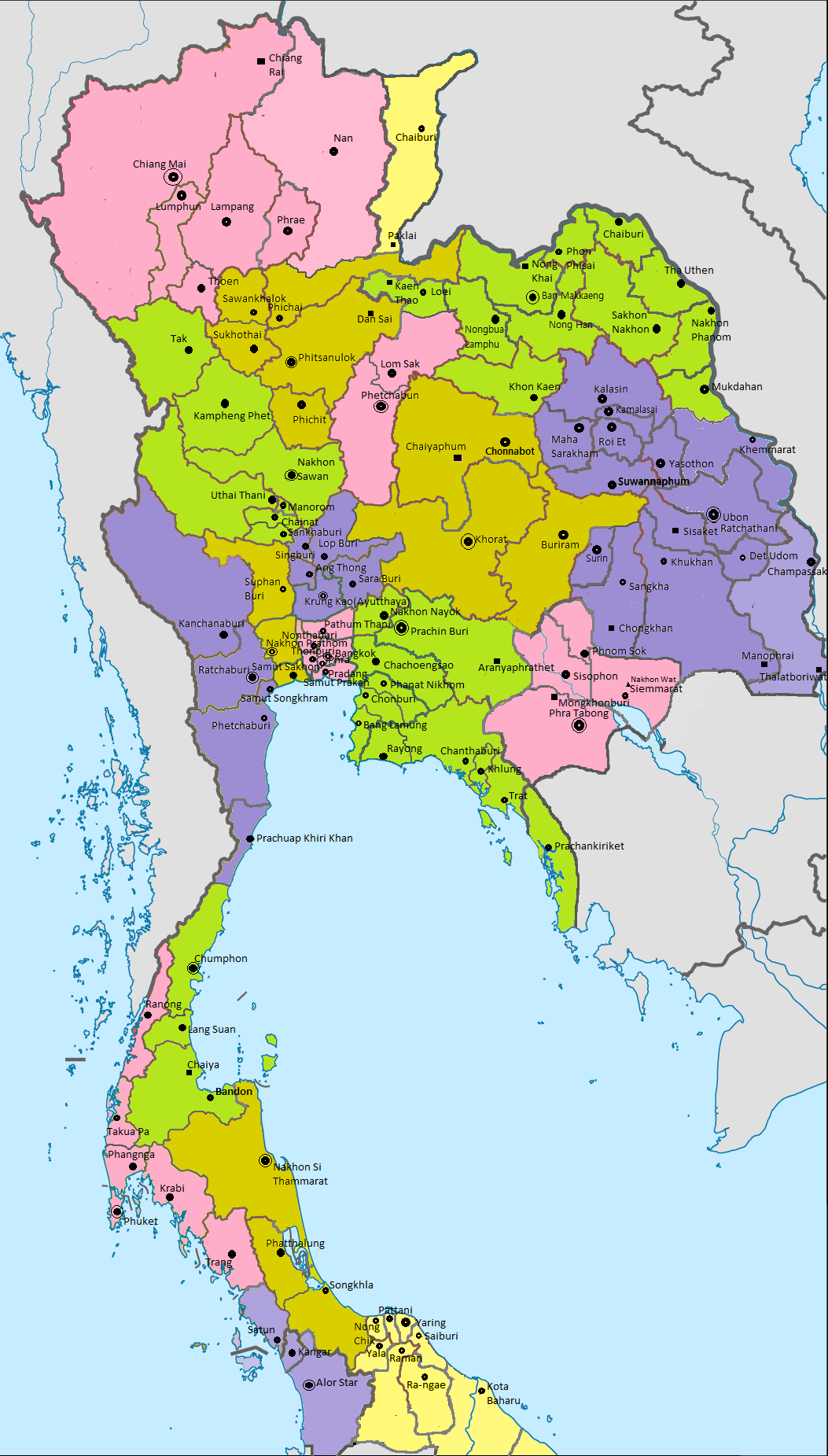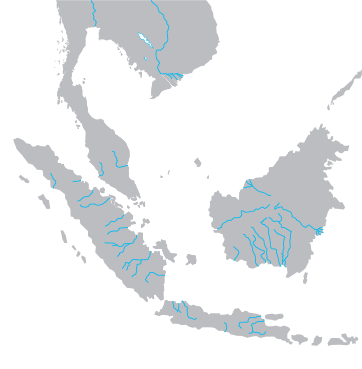|
Reman Sultanate
The Kingdom of Reman or Kingdom of Rahman (; Jawi: كراجأن رمان; ; ) was a landlocked semi-independent Malay kingdom in the northern Malay Peninsula. It was one of seven regions of Patani Kingdom, an autonomous tributary state of Siam, between 1810 and 1902. Tuan Mansor, a member of the Patani aristocracy, ascended to the throne in 1810. The state's territory straddles the present-day Malaysia–Thailand border, covering Amphoe Raman in Yala province in Thailand, as well as Hulu Perak District and parts of Jeli and Upper Kelantan regions in Malaysia. Etymology The name of the state may be derived from a Patani Malay word ''rama, cognate to standard Malay ''ramai'', meaning "a large assembly". It is likely named after a growing settlement founded in the area around the late 18th century. The earliest English-language reference of the state was made in 1818, between an agreement by the Governor of Prince of Wales' Island (Penang), John Bannerman to Tuan Long ... [...More Info...] [...Related Items...] OR: [Wikipedia] [Google] [Baidu] |
Malay Language
Malay ( , ; , Jawi alphabet, Jawi: ) is an Austronesian languages, Austronesian language spoken primarily by Malays (ethnic group), Malays in several islands of Maritime Southeast Asia and the Malay Peninsula on the mainland Asia. The language is an official language of Brunei, Malaysia, and Singapore. Indonesian language, Indonesian, a standardized variety of Malay, is the official language of Indonesia and one of the working languages of East Timor. Malay is also spoken as a regional language of Malays (ethnic group), ethnic Malays in Indonesia and the Thai Malays, southern part of Thailand. Altogether, it is spoken by 60 million people across Maritime Southeast Asia. The language is pluricentric and a ISO 639 macrolanguage, macrolanguage, i.e., a group of Mutual intelligibility, mutually intelligible speech varieties, or dialect continuum, that have no traditional name in common, and which may be considered distinct languages by their speakers. Several varieties of it ar ... [...More Info...] [...Related Items...] OR: [Wikipedia] [Google] [Baidu] |
Malay Peninsula
The Malay Peninsula is located in Mainland Southeast Asia. The landmass runs approximately north–south, and at its terminus, it is the southernmost point of the Asian continental mainland. The area contains Peninsular Malaysia, Southern Thailand, and the southernmost tip of Myanmar (Kawthaung District, Kawthaung). The island country of Singapore also has historical and cultural ties with the region. The Titiwangsa Mountains are part of the Tenasserim Hills system and form the backbone of the peninsula and the southernmost section of the central cordillera, which runs from Tibet through the Kra Isthmus, the peninsula's narrowest point, into the Malay Peninsula. The Strait of Malacca separates the Malay Peninsula from the Indonesian island of Sumatra, and the south coast is separated from the island of Singapore by the Straits of Johor. Etymology The Malay term ''Tanah Melayu'' is derived from the word ''Tanah'' (land) and ''Melayu'' (Malays (ethnic group), Malays), thus ... [...More Info...] [...Related Items...] OR: [Wikipedia] [Google] [Baidu] |
Pengkalan Hulu
Pengkalan Hulu, formerly known as Kroh or Keroh, is a town and a mukim in Hulu Perak District, Perak, Malaysia, bordering Thailand and Kedah. The nearest town on the Thailand side is Betong, Thailand, Betong in Yala province. Although described as a border town, Pengkalan Hulu is 6 km from the actual Malaysia-Thailand border which is located at Bukit Berapit, where the Malaysian customs, immigration and quarantine station is located. The town is served by both Malaysia Federal Route 76, Federal Route 76, which connects it to Gerik and Kuala Kangsar to the south and Baling in Kedah to the north, and Malaysia Federal Route 77, Federal Route 77 which goes in a northeasterly direction to Bukit Berapit and onward to Betong. It is located at a height of 380 m above sea level. Demographics Languages spoken here include Malay, Chinese (Penang Hokkien, Hokkien as well as Malaysian Cantonese, Cantonese), Tamil and Thai. The main religions are Islam, Buddhism, Hinduism, and ... [...More Info...] [...Related Items...] OR: [Wikipedia] [Google] [Baidu] |
John Alexander Bannerman
Colonel John Alexander Bannerman (5 June 1759 – 8 August 1819) was appointed Governor of Prince of Wales' Island (Penang Island, Malaysia) and Province Wellesley (Seberang Perai) (both forming the settlement of Penang) in 1817 and also Treasurer from 1818. Bannerman hoped to enter Parliament at the 1806 general election, but despite being prepared to spend £2,000 on a campaign, he failed to find a seat. However, a vacancy was created in early 1807 the resignation of Josias Porcher, MP for the pocket borough of Bletchingley which was then under the patronage of Rev. Jarvis Kenrick, and Bannerman was returned at the by-election in January 1807. He hoped to find a Treasury borough at the general election later that year, but was unsuccessful. He was a director of the East India Company for two periods after 1811. Bannerman served until his death from cholera Cholera () is an infection of the small intestine by some Strain (biology), strains of the Bacteria, bacterium ' ... [...More Info...] [...Related Items...] OR: [Wikipedia] [Google] [Baidu] |
List Of Governors Of Penang
The Governor of Penang, officially Yang di-Pertua Negeri of Penang (') is the Ceremony, ceremonial head of state of the States and federal territories of Malaysia, Malaysian state of Penang. The role of governor is largely ceremonial with the power vested in the executive branch of the Government of Penang, state government led by the Chief Minister of Penang, chief minister. The Yang di-Pertua Negeri is styled Malay styles and titles, Tuan Yang Terutama (TYT) (''English: Excellency, His Excellency''). Until the 18th century, the Penang Island, island of Penang was part of the Kedah Sultanate, Sultanate of Kedah. In 1786, the island was ceded by the sultan of Kedah to the East India Company, Francis Light representing the company. Light renamed the island ''Prince of Wales Island''. In 1790, after suffering a military defeat at the hands of Light, Sultan Abdullah formally handed over the island to the British Empire, British. Light was appointed Superintendent of Prince of Wale ... [...More Info...] [...Related Items...] OR: [Wikipedia] [Google] [Baidu] |
Standard Malay
Malaysian Malay () or Malaysian ()endonymically known as Standard Malay () or simply Malay (, abbreviated to BM)is a standardized form of the Malay language used in Malaysia and also used in Singapore and Brunei (as opposed to the variety used in Indonesia, which is referred to as the "Indonesian" language). Malaysian Malay is standardized from the Johor–Riau dialect of Malay, particularly a branch spoken in the state of Johor south of the Malay Peninsula. It is spoken by much of the Malaysian population, although most learn a vernacular Malay dialect or another native language first. Terminology In Malaysia Article 152 of Malaysia's Constitution as drafted in 1957 (revised in 1963) merely mentions "Malay" (''Bahasa Melayu'') as the designation of its "national language" without any further definition, but the term ''bahasa Malaysia'' () is used in official contexts from time to time. The latter term was endorsed by Tunku Abdul Rahman during his premiership. The ... [...More Info...] [...Related Items...] OR: [Wikipedia] [Google] [Baidu] |
Cognate
In historical linguistics, cognates or lexical cognates are sets of words that have been inherited in direct descent from an etymological ancestor in a common parent language. Because language change can have radical effects on both the sound and the meaning of a word, cognates may not be obvious, and it often takes rigorous study of historical sources and the application of the comparative method to establish whether lexemes are cognate. Cognates are distinguished from loanwords, where a word has been borrowed from another language. Name The English term ''cognate'' derives from Latin , meaning "blood relative". Examples An example of cognates from the same Indo-European root are: ''night'' ( English), ''Nacht'' ( German), ''nacht'' ( Dutch, Frisian), ''nag'' (Afrikaans), ''Naach'' ( Colognian), ''natt'' ( Swedish, Norwegian), ''nat'' ( Danish), ''nátt'' ( Faroese), ''nótt'' ( Icelandic), ''noc'' ( Czech, Slovak, Polish), ночь, ''noch'' ( Russian), но� ... [...More Info...] [...Related Items...] OR: [Wikipedia] [Google] [Baidu] |
Gua Musang District
Gua Musang ( Kelantanese: ) is a town, district and parliamentary constituency in southern Kelantan, Malaysia. It is the largest district in Kelantan. Gua Musang is administered by the Gua Musang District Council. Gua Musang district is bordered by the state of Pahang to the south, Terengganu to the east, Perak to the west and the Kelantanese districts of Kuala Krai and Jeli to the north. It is a small railway town about 140 km south of state capital Kota Bharu. Gua Musang is represented by Mohd Azizi Abu Naim in the Dewan Rakyat. The town lies on the KTM East Coast Line, from Tumpat, near the border with Thailand, to Gemas, Negeri Sembilan. The Lojing Autonomous Sub-District (Jajahan Kecil Lojing) is in the western part of Gua Musang constituency. Geography Gua Musang literally means " Civet Cat Cave". On the eastern side of this town stands Bukit Gua Musang, a barren hill of rocks and deceptive stone-steps running 105 metres high. It stands in a commanding positi ... [...More Info...] [...Related Items...] OR: [Wikipedia] [Google] [Baidu] |
Jeli District
Jeli is a district and a parliamentary constituency in western Kelantan, Malaysia. As of 2010, the district's population is estimated to be 42,150. Jeli is administered by the Jeli District Council. Jeli is bordered by Perak's Hulu Perak District to the west, the Thai district of Waeng to the north, Tanah Merah District to the northeast and Kuala Krai District to the southeast. Most people in Jeli work as rubber tappers. The rubber plantations which belong to the local people also attract people from outside to come and work. Commonly families own a small plantation of up to in size. The history of Jeli began when the government encouraged the people around Kelantan to start a great area of agriculture. This process began with a period of land clearing, or logging. History Jeli district (jajahan) was originally an autonomous sub-district (Jajahan Kecil), formed on 1 July 1982 from parts of Tanah Merah (Jeli and Belimbing) and Kuala Krai (Kuala Balah) district. It was ... [...More Info...] [...Related Items...] OR: [Wikipedia] [Google] [Baidu] |
Hulu Perak District
Hulu Perak District () is a district in Perak, Malaysia. It is the largest district in Perak. In the east of the district it borders the districts of Jeli and Gua Musang in Kelantan, to the west it borders Baling and Kulim Districts of Kedah, to the south it borders the district of Kuala Kangsar while to the south-west it borders the district of Larut, Matang and Selama. Hulu Perak also shares a border with Yala province's Betong district on the border with Thailand. The seat of the district is Gerik, which is also the largest town of the district. The highest point in the district is the Ulu Titi Basah peak in the Titiwangsa Mountains. The peak is tall and is located near the Malaysia–Thailand border and Temenggor Lake. History In 1511, after the fall of the Malacca Sultanate to the Portuguese, Sultan Mahmud Shah retreated and established his government in Bentan. In 1526 the Portuguese attacked his domain again and forced him to retreat to Kampar where he re-establi ... [...More Info...] [...Related Items...] OR: [Wikipedia] [Google] [Baidu] |






